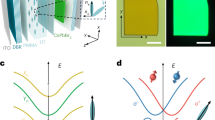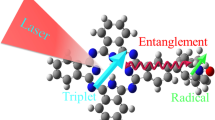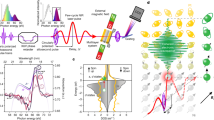Abstract
Strongly interacting spins underlie many intriguing phenomena and applications1,2,3,4 ranging from magnetism to quantum information processing. Interacting spins combined with motion show exotic spin transport phenomena, such as superfluidity arising from pairing of spins induced by spin attraction5,6. To understand these complex phenomena, an interacting spin system with high controllability is desired. Quantum spin dynamics have been studied on different platforms with varying capabilities7,8,9,10,11,12,13. Here we demonstrate tunable itinerant spin dynamics enabled by dipolar interactions using a gas of potassium-rubidium molecules confined to two-dimensional planes, where a spin-1/2 system is encoded into the molecular rotational levels. The dipolar interaction gives rise to a shift of the rotational transition frequency and a collision-limited Ramsey contrast decay that emerges from the coupled spin and motion. Both the Ising and spin-exchange interactions are precisely tuned by varying the strength and orientation of an electric field, as well as the internal molecular state. This full tunability enables both static and dynamical control of the spin Hamiltonian, allowing reversal of the coherent spin dynamics. Our work establishes an interacting spin platform that allows for exploration of many-body spin dynamics and spin-motion physics using the strong, tunable dipolar interaction.
This is a preview of subscription content, access via your institution
Access options
Access Nature and 54 other Nature Portfolio journals
Get Nature+, our best-value online-access subscription
$29.99 / 30 days
cancel any time
Subscribe to this journal
Receive 51 print issues and online access
$199.00 per year
only $3.90 per issue
Buy this article
- Purchase on Springer Link
- Instant access to full article PDF
Prices may be subject to local taxes which are calculated during checkout




Similar content being viewed by others
Data availability
The datasets generated and analysed during the current study are available from the corresponding authors on reasonable request.
References
Manousakis, E. The spin-1/2 Heisenberg antiferromagnet on a square lattice and its application to the cuprous oxides. Rev. Mod. Phys. https://doi.org/10.1103/RevModPhys.63.1 (1991).
Žutić, I., Fabian, J. & Das Sarma, S. Spintronics: fundamentals and applications. Rev. Mod. Phys. 76, 323–410 (2004).
Wineland, D. J., Bollinger, J. J., Itano, W. M., Moore, F. L. & Heinzen, D. J. Spin squeezing and reduced quantum noise in spectroscopy. Phys. Rev. A 46, R6797–R6800 (1992).
Nielsen, M. A. & Chuang, I. Quantum computation and quantum information. Am. J. Phys. 70, 558–559 (2002).
Levin, K. & Hulet, R. G. in Ultracold Bosonic and Fermionic Gases (eds. Levin, K. et al.) Vol. 5, 69–94 (Elsevier, 2012).
Sobirey, L. et al. Observation of superfluidity in a strongly correlated two-dimensional Fermi gas. Science 372, 844–846 (2021).
Bloch, I., Dalibard, J. & Nascimbène, S. Quantum simulations with ultracold quantum gases. Nat. Phys. 8, 267–276 (2012).
Labuhn, H. et al. Tunable two-dimensional arrays of single Rydberg atoms for realizing quantum Ising models. Nature 534, 667–670 (2016).
Monroe, C. et al. Programmable quantum simulations of spin systems with trapped ions. Rev. Mod. Phys. 93, 25001 (2021).
Zu, C. et al. Emergent hydrodynamics in a strongly interacting dipolar spin ensemble. Nature 597, 45–50 (2021).
Chomaz, L. et al. Dipolar physics: a review of experiments with magnetic quantum gases. Rep. Prog. Phys. (in the press).
Christakis, L. et al. Probing site-resolved correlations in a spin system of ultracold molecules. Preprint at https://doi.org/10.48550/ARXIV.2207.09328 (2022).
Yan, B. et al. Observation of dipolar spin-exchange interactions with lattice-confined polar molecules. Nature 501, 521–525 (2013).
Micheli, A., Brennen, G. K. & Zoller, P. A toolbox for lattice-spin models with polar molecules. Nat. Phys. 2, 341–347 (2006).
Barnett, R., Petrov, D., Lukin, M. & Demler, E. Quantum magnetism with multicomponent dipolar molecules in an optical lattice. Phys. Rev. Lett. 96, 190401 (2006).
Hazzard, K. R. A., Manmana, S. R., Foss-Feig, M. & Rey, A. M. Far-from-equilibrium quantum magnetism with ultracold polar molecules. Phys. Rev. Lett. 110, 75301 (2013).
Mishra, T., Greschner, S. & Santos, L. Polar molecules in frustrated triangular ladders. Phys. Rev. A 91, 43614 (2015).
Bohn, J. L., Rey, A. M. & Ye, J. Cold molecules: progress in quantum engineering of chemistry and quantum matter. Science 357, 1002–1010 (2017).
Gorshkov, A. V. et al. Quantum magnetism with polar alkali-metal dimers. Phys. Rev. A 84, 33619 (2011).
Yao, N. Y., Zaletel, M. P., Stamper-Kurn, D. M. & Vishwanath, A. A quantum dipolar spin liquid. Nat. Phys. 14, 405–410 (2018).
Kwasigroch, M. P. & Cooper, N. R. Bose-Einstein condensation and many-body localization of rotational excitations of polar molecules following a microwave pulse. Phys. Rev. A 90, 21605 (2014).
Valtolina, G. et al. Dipolar evaporation of reactive molecules to below the Fermi temperature. Nature 588, 239–243 (2020).
Matsuda, K. et al. Resonant collisional shielding of reactive molecules using electric fields. Science 370, 1324–1327 (2020).
Li, J.-R. et al. Tuning of dipolar interactions and evaporative cooling in a three-dimensional molecular quantum gas. Nat. Phys. 17, 1144–1148 (2021).
Anderegg, L. et al. Observation of microwave shielding of ultracold molecules. Science 373, 779–782 (2021).
Schindewolf, A. et al. Evaporation of microwave-shielded polar molecules to quantum degeneracy. Nature 607, 677–681 (2022).
Mueller, S. et al. Stability of a dipolar Bose-Einstein condensate in a one-dimensional lattice. Phys. Rev. A 84, 053601 (2011).
Fersterer, P. et al. Dynamics of an itinerant spin-3 atomic dipolar gas in an optical lattice. Phys. Rev. A 100, 033609 (2019).
Natale, G. et al. Bloch oscillations and matter-wave localization of a dipolar quantum gas in a one-dimensional lattice. Commun. Phys. 5, 227 (2022).
Bilitewski, T. et al. Dynamical generation of spin squeezing in ultracold dipolar molecules. Phys. Rev. Lett. 126, 113401 (2021).
Tobias, W. G. et al. Reactions between layer-resolved molecules mediated by dipolar spin exchange. Science 375, 1299–1303 (2022).
Kitagawa, M. & Ueda, M. Squeezed spin states. Phys. Rev. A 47, 5138–5143 (1993).
Leibfried, D. et al. Creation of a six-atom ‘Schrödinger cat’ state. Nature 438, 639–642 (2005).
Neyenhuis, B. et al. Anisotropic polarizability of ultracold polar 40K87Rb molecules. Phys. Rev. Lett. 109, 230403 (2012).
Seeβelberg, F. et al. Extending rotational coherence of interacting polar molecules in a spin-decoupled magic trap. Phys. Rev. Lett. 121, 253401 (2018).
Burchesky, S. et al. Rotational coherence times of polar molecules in optical tweezers. Phys. Rev. Lett. 127, 123202 (2021).
Gullion, T., Baker, D. B. & Conradi, M. S. New, compensated Carr-Purcell sequences. J. Magn. Reson. 89, 479–484 (1990).
Geier, S. et al. Floquet Hamiltonian engineering of an isolated many-body spin system. Science 374, 1149–1152 (2021).
Ni, K.-K., Rosenband, T. & Grimes, D. D. Dipolar exchange quantum logic gate with polar molecules. Chem. Sci. 9, 6830–6838 (2018).
Eisert, J., Friesdorf, M. & Gogolin, C. Quantum many-body systems out of equilibrium. Nat. Phys. 11, 124–130 (2015).
Guardado-Sanchez, E. et al. Probing the quench dynamics of antiferromagnetic correlations in a 2D quantum ising spin system. Phys. Rev. X 8, 21069 (2018).
Shenker, S. H. & Stanford, D. Black holes and the butterfly effect. J. High Energy Phys. 2014, 67 (2014).
Maldacena, J., Shenker, S. H. & Stanford, D. A bound on chaos. J. High Energy Phys. 2016, 106 (2016).
Braumüller, J. et al. Probing quantum information propagation with out-of-time-ordered correlators. Nat. Phys. 18, 172–178 (2022).
Green, A. M. et al. Experimental measurement of out-of-time-ordered correlators at finite temperature. Phys. Rev. Lett. 128, 140601 (2022).
Davis, E., Bentsen, G. & Schleier-Smith, M. Approaching the Heisenberg limit without single-particle detection. Phys. Rev. Lett. 116, 53601 (2016).
Colombo, S. et al. Time-reversal-based quantum metrology with many-body entangled states. Nat. Phys. 18, 925–930 (2022).
Gilmore, K. A. et al. Quantum-enhanced sensing of displacements and electric fields with two-dimensional trapped-ion crystals. Science 373, 673–678 (2021).
Bohn, J. L., Cavagnero, M. & Ticknor, C. Quasi-universal dipolar scattering in cold and ultracold gases. New J. Phys. 11, 55039 (2009).
Ticknor, C. Quasi-two-dimensional dipolar scattering. Phys. Rev. A 81, 42708 (2010).
Karman, T., Yan, Z. Z. & Zwierlein, M. Resonant and first-order dipolar interactions between ultracold 1Σ molecules in static and microwave electric fields. Phys. Rev. A 105, 13321 (2022).
Martin, M. J. et al. A quantum many-body spin system in an optical lattice clock. Science 341, 632–636 (2013).
Bruun, G. M. & Taylor, E. Quantum phases of a two-dimensional dipolar Fermi gas. Phys. Rev. Lett. 101, 245301 (2008).
Lee, H., Matveenko, S. I., Wang, D.-W. & Shlyapnikov, G. V. Fulde-Ferrell-Larkin-Ovchinnikov state in bilayer dipolar systems. Phys. Rev. A 96, 61602 (2017).
Peter, D., Müller, S., Wessel, S. & Büchler, H. P. Anomalous behavior of spin systems with dipolar interactions. Phys. Rev. Lett. 109, 25303 (2012).
Koschorreck, M., Pertot, D., Vogt, E. & Köhl, M. Universal spin dynamics in two-dimensional Fermi gases. Nat. Phys. 9, 405–409 (2013).
Syzranov, S. V., Wall, M. L., Gurarie, V. & Rey, A. M. Spin–orbital dynamics in a system of polar molecules. Nat. Commun. 5, 5391 (2014).
Acknowledgements
This material is based upon work supported by the US Department of Energy, Office of Science, National Quantum Information Science Research Centers, Quantum Systems Accelerator. Additional support is acknowledged from the National Science Foundation grant no. QLCI OMA-2016244, the National Science Foundation grant no. Phys-1734006, and the National Institute of Standards and Technology. J.S.H. acknowledges support from the National Research Council postdoctoral fellowship. C.M. acknowledges the NDSEG Graduate Fellowship. We thank T. Bilitewski and A. M. Rey for inspirational discussions and critical reading of the manuscript.
Author information
Authors and Affiliations
Contributions
J.-R.L., K.M., C.M., A.N.C., W.G.T., J.S.H. and J.Y. all performed the experiments, analysed the data and contributed to interpreting the results and writing the manuscript.
Corresponding authors
Ethics declarations
Competing interests
The authors declare no competing interests.
Peer review
Peer review information
Nature thanks Guido Pupillo and the other, anonymous, reviewer(s) for their contribution to the peer review of this work. Peer reviewer reports are available.
Additional information
Publisher’s note Springer Nature remains neutral with regard to jurisdictional claims in published maps and institutional affiliations.
Extended data figures and tables
Extended Data Fig. 1 A typical molecular number distribution measured via layer-resolved spectroscopy.
Grey circles are the experimental measurements. Black solid line is a fit to a summation of equally spaced Gaussian functions with a global Gaussian envelope. The width of each narrow Gaussian peak is assumed to be the same. The data is taken at |E| = 1.02 kV/cm and α = 36° (magic condition) to reduce broadening of the single-layer transition linewidth due to differential polarizability.
Extended Data Fig. 2 Noise suppression of the dynamical decoupling sequence.
Data is taken at |E| = 1.02 kV/cm and α = 0°. We use X-echo only, which provides similar performance to XY8 in terms of rejecting noise in Δ. Each data point is extracted from 10 repetitions. The dashed line is the noise floor of our measurement.
Supplementary information
Rights and permissions
Springer Nature or its licensor (e.g. a society or other partner) holds exclusive rights to this article under a publishing agreement with the author(s) or other rightsholder(s); author self-archiving of the accepted manuscript version of this article is solely governed by the terms of such publishing agreement and applicable law.
About this article
Cite this article
Li, JR., Matsuda, K., Miller, C. et al. Tunable itinerant spin dynamics with polar molecules. Nature 614, 70–74 (2023). https://doi.org/10.1038/s41586-022-05479-2
Received:
Accepted:
Published:
Issue Date:
DOI: https://doi.org/10.1038/s41586-022-05479-2
This article is cited by
Comments
By submitting a comment you agree to abide by our Terms and Community Guidelines. If you find something abusive or that does not comply with our terms or guidelines please flag it as inappropriate.



